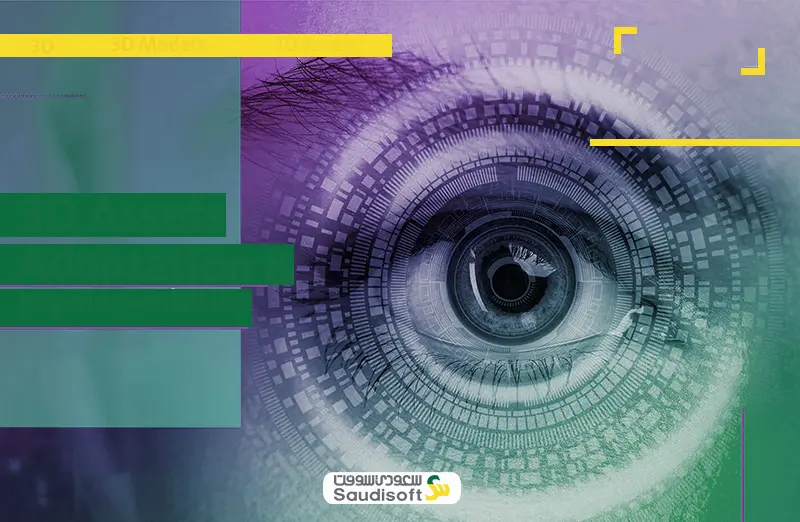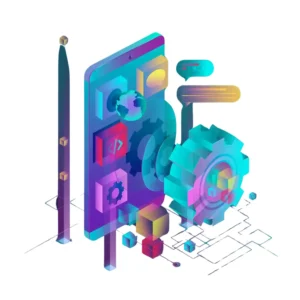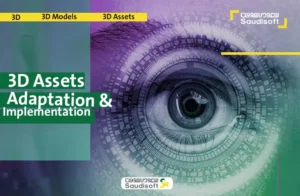Contents
Toggle3D Assets Adaptation & Implementation
Within the realm of computer graphics, animation and video games 3D assets have a vital role in creating visual experiences that resonate with their consumer. 3D assists are crucial whether the product is a game, an animation or a film as they help in creating immersive and realistic virtual worlds.
The 3D assets and its different types require adaptation so the final product would be suitable for a global audience. 3D asset adaptation involves modifying and optimizing 3D models, VDBs, Alembics, and LODs for different applications or environments.
The 3D assets and its different types require adaptation so the final product would be suitable for a global audience. 3D asset adaptation involves modifying and optimizing 3D models, VDBs, Alembics, and LODs for different applications or environments.
 3D Model Optimization:
3D Model Optimization:
3D asset optimization is not only used in games. They are essential in ecommerce too as they give consumers a better understanding of products. They will allow the customer to see their products in a way that is close to reality by using different sizes.
In games, the 3D assets optimization is essential to maintain the same smooth gameplay experiences across different hardware systems. The 3D modeling optimization in video games is about refining and adjusting 3D models to ensure they are visually marvelous and efficient.
There are different techniques for optimizing 3D models, choosing the right one depends on the purpose of the model.
These are some of the key methods used in the adaptation process:
In games, the 3D assets optimization is essential to maintain the same smooth gameplay experiences across different hardware systems. The 3D modeling optimization in video games is about refining and adjusting 3D models to ensure they are visually marvelous and efficient.
There are different techniques for optimizing 3D models, choosing the right one depends on the purpose of the model.
These are some of the key methods used in the adaptation process:
🔰 Mesh Simplification: Reducing the complexity of the mesh to decrease polygon counts without sacrificing visual quality.
🔰 Texture Compression: Minimizing texture sizes while maintaining quality.
🔰 Level of Detail (LOD) Generation: Creating multiple versions of models with varying detail levels for efficient rendering based on distance.
🔰UV Mapping Optimization: Arranging UV maps to minimize distortion and enhance rendering speed.
🔰 Material and Shader Optimization: Streamlining materials and shaders to improve performance. n
🔰 Texture Compression: Minimizing texture sizes while maintaining quality.
🔰 Level of Detail (LOD) Generation: Creating multiple versions of models with varying detail levels for efficient rendering based on distance.
🔰UV Mapping Optimization: Arranging UV maps to minimize distortion and enhance rendering speed.
🔰 Material and Shader Optimization: Streamlining materials and shaders to improve performance. n
 Challenges in 3D Asset Adaptation:
Challenges in 3D Asset Adaptation:
3D assets are complex, and their adaptation is as complex as they are. Especially when there is a variety of file formats involved.
– File Complexity: 3D models consist of lots of components such as textures, meshes and animations that need systems capable of handling diverse data types.
– Adaptation for Different Platforms: in the adaptation process we need to ensure compatibility and performance across devices as 3D assets often need to be adapted for various platforms, which may involve format conversion and optimization.
– File Complexity: 3D models consist of lots of components such as textures, meshes and animations that need systems capable of handling diverse data types.
– Adaptation for Different Platforms: in the adaptation process we need to ensure compatibility and performance across devices as 3D assets often need to be adapted for various platforms, which may involve format conversion and optimization.
Services Offered in 3D Assets Adaptation & Implementation
🔰 Localization of Content:
Localization can enhance the adaptation process by ensuring 3D models assets are optimized for the targeted environments and applications
🔰 Improving Visual Accuracy Through Localization nnModel-constrained SLAM can leverage 3D mesh models to achieve accurate real-time camera localization, reducing drift and enhancing tracking accuracy.3D assets need to be precisely aligned with the real world.
🔰 Adapting Assets Based on the Target Audience
Localization package allows developers to use different asset files, based on a specific target, enabling the adaptation of 3D assets to suit the preferences or the requirements of different regions or cultures, ensuring a more tailored user experience.
🔰 Software localization in 3D Asset Adaptation and Implementation
Software localization plays a crucial role in the 3D assets adaptation and implementation, particularly when using tools like Cinema 4D, After Effects, and Unity. Software utilization enhances the quality and effectiveness of visual adaptations to ensure that 3D assets meet the specific needs of diverse audiences.
🔰 Multi-language Support:
For cinema 4D is available in various languages, including Arabic, which broadens its accessibility for global teams and enhances collaboration in localized projects.
🔰 Effects Implementation:
To enhance the visual appeal of the localized content. Users can apply these effects to 3D assets to ensure they align with the aesthetic preferences of different regions.
Localization can enhance the adaptation process by ensuring 3D models assets are optimized for the targeted environments and applications
🔰 Improving Visual Accuracy Through Localization nnModel-constrained SLAM can leverage 3D mesh models to achieve accurate real-time camera localization, reducing drift and enhancing tracking accuracy.3D assets need to be precisely aligned with the real world.
🔰 Adapting Assets Based on the Target Audience
Localization package allows developers to use different asset files, based on a specific target, enabling the adaptation of 3D assets to suit the preferences or the requirements of different regions or cultures, ensuring a more tailored user experience.
🔰 Software localization in 3D Asset Adaptation and Implementation
Software localization plays a crucial role in the 3D assets adaptation and implementation, particularly when using tools like Cinema 4D, After Effects, and Unity. Software utilization enhances the quality and effectiveness of visual adaptations to ensure that 3D assets meet the specific needs of diverse audiences.
🔰 Multi-language Support:
For cinema 4D is available in various languages, including Arabic, which broadens its accessibility for global teams and enhances collaboration in localized projects.
🔰 Effects Implementation:
To enhance the visual appeal of the localized content. Users can apply these effects to 3D assets to ensure they align with the aesthetic preferences of different regions.
 Quality Assurance for 3D Assets Adaptation & Implementation
Quality Assurance for 3D Assets Adaptation & Implementation
Quality assurance is vital to ensure that the final products meet user expectations and industry standards. Effective QA can lead to improved accuracy, enhance visual quality and reduce errors.
– Final Review: We perform a meticulous final review of all implemented localizations to ensure accuracy and cultural appropriateness.
– Issue Identification: We flag any potential issues during the review process to maintain the highest quality standards.
– Issue Resolution: We promptly address and fix any identified issues, ensuring the final product meets all client expectations.🔰 Customer Involvement in QA
Customer feedback is important in the QA process, as it helps the models to meet specific requirements. Effective communication between customers and modelers can enhance the QA process. Providing straightforward and concise comments helps developers understand and implement necessary changes effectively.
– Final Review: We perform a meticulous final review of all implemented localizations to ensure accuracy and cultural appropriateness.
– Issue Identification: We flag any potential issues during the review process to maintain the highest quality standards.
– Issue Resolution: We promptly address and fix any identified issues, ensuring the final product meets all client expectations.🔰 Customer Involvement in QA
Customer feedback is important in the QA process, as it helps the models to meet specific requirements. Effective communication between customers and modelers can enhance the QA process. Providing straightforward and concise comments helps developers understand and implement necessary changes effectively.


 3D Model Optimization:
3D Model Optimization: Quality Assurance for 3D Assets Adaptation & Implementation
Quality Assurance for 3D Assets Adaptation & Implementation



